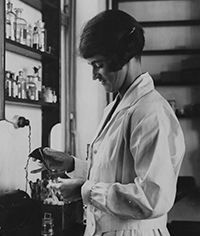◄ Back to Blood Service in Brief October 2016
Australia has a very long and proud history of women contributing to, and working in, leadership roles in the field of blood science.
Women have not only excelled in blood science in Australia—they have been at the leading edge.
Now we’re acknowledging some of the countless women who have played a vital role in establishing, developing and continuing to grow the Blood Service into the organisation you see today.
From the very beginning women have played an important role in the establishment of blood donation in Australia, with pioneers Dr Lucy Bryce and Dr Ruth Sanger at the forefront. Dr Bryce is credited with founding the first Australian blood service. Dr Sanger established the basis for Rh blood groups and her book, Blood Groups in Man, co-authored with Robert Race and published in 1950, was a definitive reference for 30 years.
The Second World War impacted many fields and blood donation was no exception. Dr Bryce continued to direct the Blood Service during this time, with female doctors Ella Macknight, Dorothy Synan, Joy Bell and Isabel Ireland all collecting blood from mainly female donors. Those donors were tended to by female voluntary aides, who were trained and supervised by female leaders to clean and sterilise the equipment, while European doctors Rachel Jakobowicz and Margaret Karoly performed the blood grouping of donors for troops.
As social historian Matthew Klugman saw it in his book, Blood Matters: “The women doctors and scientists were doing more than just running the Blood Service, they were at the forefront of international research into blood and blood transfusions”.
Work at the Blood Service over the last 80 years has transformed, with the emergence of new diseases and technologies driving significant changes. Associate Professor Catherine Hyland (Cate) started work at the Queensland Red Cross Blood Service as a scientist in clinical biochemistry. During her significant career she has been a part of major milestones that changed the way we work, including the emergence of HIV and the introduction of HIV screening for the entire blood supply in the 1980s — a move in which Australia was among the first in the world. “It was a very serious time, but also a time of learning, cooperation and collaboration,” she explains.
Changes in computerisation and the genetic revolution have also played their part. “In the late 80s the ability to amplify DNA revolutionised the testing laboratories and formed the basis of our modern genotyping work,” Cate reflects.
Cate now uses leading edge genetic technologies in her work in the Blood Service’s Research and Development team to improve the matching of blood between donors and patients and to solve the mysteries of rare blood groups important for transfusion safety.
While things have come a long way since glass collection bottles, the hand-sharpening of needles, and the fear of the unknown during the AIDS crisis, women are still making a difference in scientific and leadership roles at the Blood Service.
Shining a light on female blood scientists and researchers
With efforts to encourage women to choose, and continue working in, the fields of science, technology, engineering and maths, and to bridge the gender pay gap, the Blood Service looks towards a bright future for women in science.
- Dr Helen Faddy leads a team that studies emerging diseases and their impact on the blood supply.
- Dr Melinda Dean and her group examine the detailed biology of patients’ responses to blood transfusions.
- Dr Denese Marks heads a team that is a world-leader in frozen blood development and develops improved methods for processing and storing blood components.
- Dr Tanya Davison, a clinical psychologist, heads a national team that studies ways to make sure our donors stay happy and healthy.
Photo: A young Dr Lucy Bryce at work in a laboratory in the late 1920s. Dr Bryce would go on to establish the first Australian blood service with the Australian Red Cross Society. Photo: University of Melbourne Archives.

